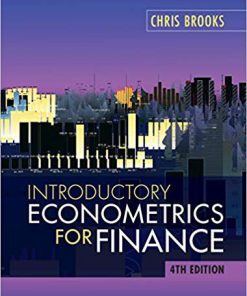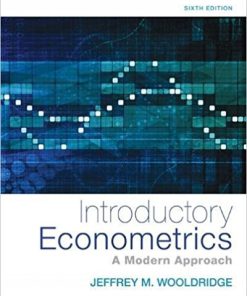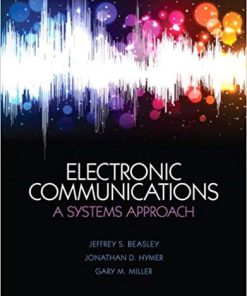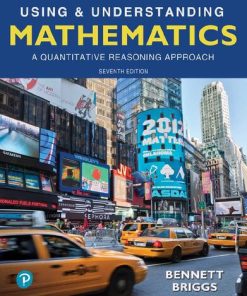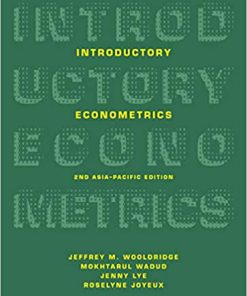(eBook PDF) Introductory Econometrics: A Modern Approach 7th Edition by Jeffrey
$50.00 Original price was: $50.00.$35.00Current price is: $35.00.
(eBook PDF) Introductory Econometrics: A Modern Approach 7th Edition by Jeffrey – Instant Download
(eBook PDF) Introductory Econometrics: A Modern Approach 7th Edition by Jeffrey – Digital Ebook – Instant Delivery Download

Product details:
- ISBN-10 : 1337558869
- ISBN-13 : 978-1337558860
- Author: Jeffrey M. Wooldridge
This book is a standalone book and will not include any access codes. Discover how empirical researchers today actually consider and apply econometric methods with the practical approach in Wooldridge’s INTRODUCTORY ECONOMETRICS: A MODERN APPROACH, 6E. Unlike traditional texts, this book uniquely demonstrates how econometrics has moved beyond a set of abstract tools to become genuinely useful for answering questions in business, policy evaluation, and forecasting. INTRODUCTORY ECONOMETRICS is organized around the type of data being analyzed with a systematic approach that only introduces assumptions as they are needed. This makes the material easier to understand and, ultimately, leads to better econometric practices. Packed with relevant applications, the text incorporates more than 100 intriguing data sets, available in six formats. Updates introduce the latest emerging developments in the field. Gain a full understanding of the impact of econometrics in practice today with the insights and applications found only in INTRODUCTORY ECONOMETRICS: A MODERN APPROACH, 6E.
Table of Content:
- Ch 1: The Nature of Econometrics and Economic Data
- 1-1 What is Econometrics?
- 1-2 Steps in Empirical Economic Analysis
- 1-3 The Structure of Economic Data
- 1-4 Causality and the Notion of Ceteris Paribus in Econometric Analysis
- Summary
- Key Terms
- Problems
- Computer Exercises
- Part 1: Regression Analysis with Cross-Sectional Data
- Ch 2: The Simple Regression Model
- 2-1 Definition of the Simple Regression Model
- 2-2 Deriving the Ordinary Least Squares Estimates
- 2-3 Properties of OLS on Any Sample of Data
- 2-4 Units of Measurement and Functional Form
- 2-5 Expected Values and Variances of the OLS Estimators
- 2-6 Regression through the Origin and Regression on a Constant
- Summary
- Key Terms
- Problems
- Computer Exercises
- Appendix 2A
- Ch 3: Multiple Regression Analysis: Estimation
- 3-1 Motivation for Multiple Regression
- 3-2 Mechanics and Interpretation of Ordinary Least Squares
- 3-3 The Expected Value of the OLS Estimators
- 3-4 The Variance of the OLS Estimators
- 3-5 Efficiency of OLS: The Gauss-Markov Theorem
- 3-6 Some Comments on the Language of Multiple Regression Analysis
- Summary
- Key Terms
- Problems
- Computer Exercises
- Appendix 3A
- Ch 4: Multiple Regression Analysis: Inference
- 4-1 Sampling Distributions of the OLS Estimators
- 4-2 Testing Hypotheses about a Single Population Parameter: The t Test
- 4-3 Confidence Intervals
- 4-4 Testing Hypotheses about a Single Linear Combination of the Parameters
- 4-5 Testing Multiple Linear Restrictions: The F Test
- 4-6 Reporting Regression Results
- Summary
- Key Terms
- Problems
- Computer Exercises
- Ch 5: Multiple Regression Analysis: OLS Asymptotics
- 5-1 Consistency
- 5-2 Asymptotic Normality and Large Sample Inference
- 5-3 Asymptotic Efficiency of OLS
- Summary
- Key Terms
- Problems
- Computer Exercises
- Appendix 5A
- Ch 6: Multiple Regression Analysis: Further Issues
- 6-1 Effects of Data Scaling on OLS Statistics
- 6-2 More on Functional Form
- 6-3 More on Goodness-of-Fit and Selection of Regressors
- 6-4 Prediction and Residual Analysis
- Summary
- Key Terms
- Problems
- Computer Exercises
- Appendix 6A
- Ch 7: Multiple Regression Analysis with Qualitative Information: Binary (or Dummy) Variables
- 7-1 Describing Qualitative Information
- 7-2 A Single Dummy Independent Variable
- 7-3 Using Dummy Variables for Multiple Categories
- 7-4 Interactions Involving Dummy Variables
- 7-5 A Binary Dependent Variable: The Linear Probability Model
- 7-6 More on Policy Analysis and Program Evaluation
- 7-7 Interpreting Regression Results with Discrete Dependent Variables
- Summary
- Key Terms
- Problems
- Computer Exercises
- Ch 8: Heteroskedasticity
- 8-1 Consequences of Heteroskedasticity for OLS
- 8-2 Heteroskedasticity-Robust Inference after OLS Estimation
- 8-3 Testing for Heteroskedasticity
- 8-4 Weighted Least Squares Estimation
- 8-5 The Linear Probability Model Revisited
- Summary
- Key Terms
- Problems
- Computer Exercises
- Ch 9: More on Specification and Data Issues
- 9-1 Functional Form Misspecification
- 9-2 Using Proxy Variables for Unobserved Explanatory Variables
- 9-3 Models with Random Slopes
- 9-4 Properties of OLS under Measurement Error
- 9-5 Missing Data, Nonrandom Samples, and Outlying Observations
- 9-6 Least Absolute Deviations Estimation
- Summary
- Key Terms
- Problems
- Computer Exercises
- Part 2: Regression Analysis with Time Series Data
- Ch 10: Basic Regression Analysis with Time Series Data
- 10-1 The Nature of Time Series Data
- 10-2 Examples of Time Series Regression Models
- 10-3 Finite Sample Properties of OLS under Classical Assumptions
- 10-4 Functional Form, Dummy Variables, and Index Numbers
- 10-5 Trends and Seasonality
- Summary
- Key Terms
- Problems
- Computer Exercises
- Ch 11: Further Issues in Using OLS with Time Series Data
- 11-1 Stationary and Weakly Dependent Time Series
- 11-2 Asymptotic Properties of OLS
- 11-3 Using Highly Persistent Time Series in Regression Analysis
- 11-4 Dynamically Complete Models and the Absence of Serial Correlation
- 11-5 The Homoskedasticity Assumption for Time Series Models
- Summary
- Key Terms
- Problems
- Computer Exercises
- Ch 12: Serial Correlation and Heteroskedasticity in Time Series Regressions
- 12-1 Properties of OLS with Serially Correlated Errors
- 12-2 Testing for Serial Correlation
- 12-3 Correcting for Serial Correlation with Strictly Exogenous Regressors
- 12-4 Differencing and Serial Correlation
- 12-5 Serial Correlation-Robust Inference after OLS
- 12-6 Heteroskedasticity in Time Series Regressions
- Summary
- Key Terms
- Problems
- Computer Exercises
- Part 3: Advanced Topics
- Ch 13: Pooling Cross Sections across Time: Simple Panel Data Methods
- 13-1 Pooling Independent Cross Sections across Time
- 13-2 Policy Analysis with Pooled Cross Sections
- 13-3 Two-Period Panel Data Analysis
- 13-4 Policy Analysis with Two-Period Panel Data
- 13-5 Differencing with More Than Two Time Periods
- Summary
- Key Terms
- Problems
- Computer Exercises
- Appendix 13A
- Ch 14: Advanced Panel Data Methods
- 14-1 Fixed Effects Estimation
- 14-2 Random Effects Models
- 14-3 The Correlated Random Effects Approach
- 14-4 Applying Panel Data Methods to Other Data Structures
- Summary
- Key Terms
- Problems
- Computer Exercises
- Appendix 14A
- Ch 15: Instrumental Variables Estimation and Two Stage Least Squares
- 15-1 Motivation: Omitted Variables in a Simple Regression Model
- 15-2 IV Estimation of the Multiple Regression Model
- 15-3 Two Stage Least Squares
- 15-4 IV Solutions to Errors-in-Variables Problems
- 15-5 Testing for Endogeneity and Testing Overidentifying Restrictions
- 15-6 2SLS with Heteroskedasticity
- 15-7 Applying 2SLS to Time Series Equations
- 15-8 Applying 2SLS to Pooled Cross Sections and Panel Data
- Summary
- Key Terms
- Problems
- Computer Exercises
- Appendix 15A
- Ch 16: Simultaneous Equations Models
- 16-1 The Nature of Simultaneous Equations Models
- 16-2 Simultaneity Bias in OLS
- 16-3 Identifying and Estimating a Structural Equation
- 16-4 Systems with More Than Two Equations
- 16-5 Simultaneous Equations Models with Time Series
- 16-6 Simultaneous Equations Models with Panel Data
- Summary
- Key Terms
- Problems
- Computer Exercises
- Ch 17: Limited Dependent Variable Models and Sample Selection Corrections
- 17-1 Logit and Probit Models for Binary Response
- 17-2 The Tobit Model for Corner Solution Responses
- 17-3 The Poisson Regression Model
- 17-4 Censored and Truncated Regression Models
- 17-5 Sample Selection Corrections
- Summary
- Key Terms
- Problems
- Computer Exercises
- Appendix 17A
- Appendix 17B
- Ch 18: Advanced Time Series Topics
- 18-1 Infinite Distributed Lag Models
- 18-2 Testing for Unit Roots
- 18-3 Spurious Regression
- 18-4 Cointegration and Error Correction Models
- 18-5 Forecasting
- Summary
- Key Terms
- Problems
- Computer Exercises
- Ch 19: Carrying out an Empirical Project
- 19-1 Posing a Question
- 19-2 Literature Review
- 19-3 Data Collection
- 19-4 Econometric Analysis
- 19-5 Writing an Empirical Paper
- Summary
- Key Terms
- Sample Empirical Projects
- List of Journals
- Data Sources
- Appendix A: Basic Mathematical Tools
- Appendix B: Fundamentals of Probability
- Appendix C: Fundamentals of Mathematical Statistics
- Appendix D: Summary of Matrix Algebra
- Appendix E: The Linear Regression Model in Matrix Form
- Appendix F: Answers to Chapter Questions
- Appendix G: Statistical Tables
- References
- Glossary
- Index
People Also Search:
introductory econometrics a modern approach
introductory econometrics a modern approach wooldridge
introductory econometrics a modern approach 6th edition wooldridge
introductory econometrics a modern approach 6th edition
introductory econometrics a modern approach 6th edition testbank download pdf
introductory econometrics a modern approach 6th edition download scribd
You may also like…
Business & Economics - Mathematical Economics
Introductury Econometrics: A Modern Approach 7th Edition Jeffrey M. Wooldridge – eBook PDF




